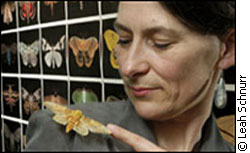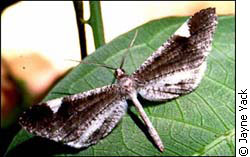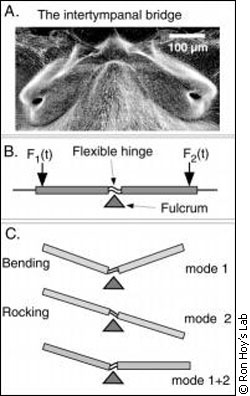| Wiretapping
the insect world
By Chris Clarke
OTTAWA —
In the H.H.J. Nesbitt Building
at Carleton University hangs a display of 40 moths,
eerily life like. Each looks ready to fly at the slightest
provocation.
Biologist Dr. Jayne Yack works down the
hall from the gallery. She's an animal behaviourist
with a penchant for butterflies, sounds and bitter chocolate.
“I’ve always been fascinated
with the sensory world of animals,” Yack says.
“Any way that an insect can evolve to hear a sound,
I want to find out.”
Yack has devoted the last 15 years to
studying the hearing of the insect order Lepidoptera,
which includes 160,000 different species of moths, butterflies
and skippers. Six years ago she started listening to
butterflies solely. This devotion has led to some radical
and influential insights and theories on butterfly evolution.
 |
| Dr. Jayne Yack
recently recieved $285,000 in grants to buy equipment
needed to continue her research. |
She works in a crowded office. Countless
reports, manila folders, printouts, notes, and journal
articles are stacked on her desk. Over it, pinned to
a bulletin board, are pictures of her family, highly
magnified butterfly ears, printouts of sound wave patterns
from caterpillars, and a simple insect classification
table. She doesn’t need the table but it’s
a useful tool to help explain the difference between
a butterfly and a moth to people who can't tell them
apart.
Yack is in the midst of ordering new equipment
for the laboratory. The $285,000 grant awarded to her
last year by the Canada Foundation for Innovation, with
matching funds from the Ontario Innovation Trust, has
finally come in. She is buying the equipment she desperately
needs: a portable laser vibrometer, an electrophysiology
rig, a soundproof room and high-speed video equipment
top the list.
These instruments are necessary for Yack’s
research into bioacoustics and the neuroethology of
insect hearing. Neuroethology is the junction of neural
sciences, animal behaviourism and animal biology.
“It’s an attempt to understand
the neural mechanisms behind behaviour and the evolution
of behaviour,” she explains.
Before the grant, Yack traveled to university
labs in Toronto and New York to conduct her studies.
In the summer of 2004, Yack and Sarah Brown, a first-year
Carleton University masters student, hauled plastic
containers filled with potted plants halfway across
campus to the university’s only soundproof room.
In the room, the pair painstakingly recorded the clickings
from Antherea polyphemus caterpillars that
lived off the plants.
The recordings are part of a project designed
to show how some caterpillars communicate with each
other and establish territory. It’s one of three
ongoing experiments exploring caterpillar communication
and its effect on the insect's social organization and
behaviour.
Around the corner from her office at Yack’s
lab, Brown goes through this data. She measures and
counts the spikes in the audio wavelength printouts.
She is trying to show how the sounds correspond to different
situations. She is compiling evidence to support her
theories behind the clicking sounds made by caterpillars.
Three years ago, Brown never imagined she would enjoy
listening to the cries of a caterpillar.
| 'You miss
the details in everyday life but once you look at
them, you see the complexities and it goes from
being scary or intimidating to beautiful.' |
Chalk it up to Yack’s intense passion
for butterfly hearing.
Her students describe her enthusiasm as
contagious. It’s so infectious that most of Yack’s
researchers are former students of her third-year animal
behaviour class. Brown changed her field of study after
she took the course.
Fourth-year biology student Tiffany Timbers,
another undergraduate researcher, credits the biologist
for changing her attitude towards insects. Once disgusted,
she is now lured by the intricacies of the bugs.
“You miss the details in everyday
life but once you look at them [insects], you see the
complexities and it goes from being scary or intimidating
to beautiful,” Timbers says. “I’m
not enjoying just the organism but enjoying what its
complexities are ultimately going to tell you about
it.”
Her research is getting more and more
popular. Yack will be gaining an four or five more student
researchers for the summer in addition to the seven
she already has working in her lab. And it’s only
her first year with student researchers.
Perhaps it’s the work she’s
done – providing insight into the evolution of
butterflies – that attracts students.
In 2000, a paper published by Yack and
Dr. James Fullard, a University of Toronto biologist,
in the science journal Nature, concluded that
bats created modern-day butterflies.
Evolutionary war games
Research suggests at some point, over
50 million years ago, moths and butterflies both flew
during the night. But something happened and butterflies
started flying during the day. Around the same time,
bats evolved the ability to use echolocation, a sonar
radar system where bats emit high frequency sounds that
bounce off objects and back to the bat. Bats became
incredibly lethal hunters of flying insects.
Echolocation proved devastating on moths
and butterflies and it had important consequences for
the two species. Moths stayed nocturnal and developed
ears to detect the ultrasonic squeaks of bats; butterflies
abandoned the night and the predator altogether.
Enter a unique species of butterfly native
to Panama known as hedylids. Hedylids are a nocturnal
butterfly with moth-like ear structures on their wings.
The ears resemble little rabbit ears and are basically
a thin membrane, like a drum skin, stretched over an
air sac. This organ, called a tympanal organ, is very
sensitive to vibrations.
 |
| Hedylid butterflies most
likely evolved ears to escape bats and are considered
living ancestors to modern butterflies. |
Yack videotaped a few hedylids as she
played ultrasound that mimicked bats. The hedylids went
into evasive action, spiraling, dive bombing and flying
in upward and downward loops to avoid the virtual "bat.”
She removed the hearing organs, performed the same experiment
and found the butterflies didn’t react at all.
While not a direct evolutionary link,
Yack believes these night butterflies are more of an
ecological link between moths and butterflies. Hedylids
are more like living ancestors to modern butterflies.
However, the insect world is hardly ever
simple. Some butterfly ears act to detect predators.
Some butterflies communicate to each other through their
ears. A species of the Hamadryas butterfly will group
together and fly in spirals clicking at each other.
To complicate the matter, there are many
theories about the hearing structures’ actual
function. One theory suggests butterfly ears may act
as a barometer, detecting changes in pressure, and not
as a form of hearing. Yack says this hypothesis shows
how little research has been done on the insect. She
intends to prove the hearing hypothesis through collecting
more evidence with her new lab equipment.
“What are these structures designed
to pick up those signals important to a species’
survival?” she asks.
It’s a common question. One asked
by Dr. Andrew Mason, a University of Toronto professor
and biologist. Mason doesn’t have a focal insect
like Yack; instead, he is drawn to a number of bugs,
publishing papers on jumping spiders, katydids and flies.
Like Yack, his interest in communication
and sounds fostered a curiosity into how the nervous
system is designed to interpret brain waves produced
by sounds.
He studies insects because it is more
practical to look at simpler structures to find basic
principles of hearing, and the effects on thinking and
behaviour. Once you find these basics, you are more
likely to find the same principles elsewhere.
“Insects are easier to experiment
with so you can look at general questions not easily
explored with vertebrates,” Mason says.
| 'Insects
are easier to experiment with so you can look at
general questions not easily explored with vertebrates.' |
Hearing aid evolution
Mason’s research has yielded some
surprising applications. His work with Cornell’s
Dr. Ron Hoy and Dr. Ron Miles, chair of mechanical engineering
at Binghamton University, into the remarkable hearing
of the parasite fly, Ormia ochracea, will probably
revolutionize hearing aids.
“When this fly came along, it was
especially interesting because it was doing something
different,” Mason says. “There was some
novel principle at work and this principle had applications.”
Ormia uses its incredible hearing
to find singing crickets in the night without visual
cues. The fly needs to find a cricket so it can lay
its eggs in it. Later, the unlucky cricket will feel
the squirming larva burst from its stomach.
But how the Ormia fly found crickets
baffled researchers because the fly’s ears were
too close together. The hearing organs, located behind
the head and only two millimeters apart, violated two
principles that guide almost every animals’ hearing,
including humans.
The first, interaural time difference,
is the difference in time it takes for sound to reach
your ears. For instance, if a noise happens to the left
of a person, the sound will reach the left ear slightly
before the right. The brain interprets the signal as
coming more from the left and the person will look that
way.
The second principle, interaural level
difference, concerns the difference in sound intensity.
If a noise happens to the left, it will sound louder
in the left ear than the right.
The Ormia fly’s ears are
so close together, however, it would be impossible to
distinguish sounds from the left and the right because
there is no time delay or noise difference. The fly
would hear only a cacophony of noise.
What researchers found was a link between
the fly’s ears.
Like butterflies, Ormia ears
are like simple drum skins but the two hearing organs
are linked by a bridge. This hinged bridge rocks up
and down, back and forth, like a seesaw.
 |
| Ormia's tympanal bridge may
lead to a a working directional mic model and revolutionize
hearings aids. |
When sound vibrations hit the bridge,
the rocking hinges deflect and amplify the vibrations,
creating a measurable difference in both time and level
of sound.
The nervous system can then easily figure
out which side the noise comes from.
This bridge is believed to be unique in
the animal kingdom. This uniqueness may pay out massive
dividends by paving the way for a new model of hearing
aid.
The problem with the modern hearing aid
is its amplification of all sounds — it cannot
filter unnecessary noise.
Consider, for example, two people are
dining at a patio restaurant. In order to hear each
other speak, their ears block the noise of traffic,
other conversations, and the other beeps and hums of
modern day life. However, when someone turns up their
hearing aid to hear a conversation better, it increases
all the surrounding noise as well.
This problem is not new. Advances in digital
signal processing have vastly improved hearing aids,
but the same problem persists. Miles says hearing aid
developers have spent the past decade searching for
a workable model using directional microphones.
Directional mics would focus noise coming
from the front of a person, where most conversation
occurs. But a practical, easy-to-reproduce model kept
slipping through the fingers of researchers.
Instead, the answer comes from bioacoustic
research into how a parasitic fly finds its gruesome
nest.
“Ormia provides a significantly
different way of creating directional mics that have
a chance of working better than other approaches,”
says Miles.
Once development is complete, “ormiaphones”
will most likely be cheaper to produce than current
hearing aids, he adds.
| 'It’s
harder than making a car or an airplane because
they’ve been made for decades. We’re
making something never made before.' |
Although Miles says the project is ahead
of schedule, there are still a slew of tiny details
to discover, adjust and solve.
“It’s harder than making a
car or an airplane because they’ve been made for
decades. We’re making something never made before,”
Miles said.
Curiosity vs practical applications
Although this work will have significant
implications for humans, Mason is not worried about
whether his research will have any real world applications.
“It’s not really practical
to go prospecting for a bug doing something strange
that can be applied to real life or put into some formula,”
he says. “If you want to discover things you don’t
know, you have to be generally curious. It’s basic
curiosity that leads to potentially useful facts.”
Nevertheless, Mason finds himself making
more friends in the engineering department. He says
he is more aware of the overlap of his studies with
engineering problems.
“I’m not changing my studies
but I am changing who I talk to.”
Likewise, Yack doesn’t worry about
searching for immediate applications either. She’s
worried more about collecting sound data. Each day she
spends on her passion, new insights are made into the
butterfly world.
“I’m trying to provide good
biology, good knowledge so people can do whatever they
want with it.”
She too is making some surprise collaborations
through her work with caterpillar communication.
Caterpillars talk using vibrations. Groups
in England and Venezuela are figuring out a way to measure
these vibrations so they can calculate how many caterpillars
of a given species are in a forest. This may lead to
better pest control.
Although she has made advances into some
areas of butterfly hearing, Yack is not afraid to look
at her work with a critical eye. Considering the nuances
of butterfly hearing, she finds it is necessary to question
her own work.
“The structure is like nothing else….
you always have to be asking: what else can it be?”
she says.
|